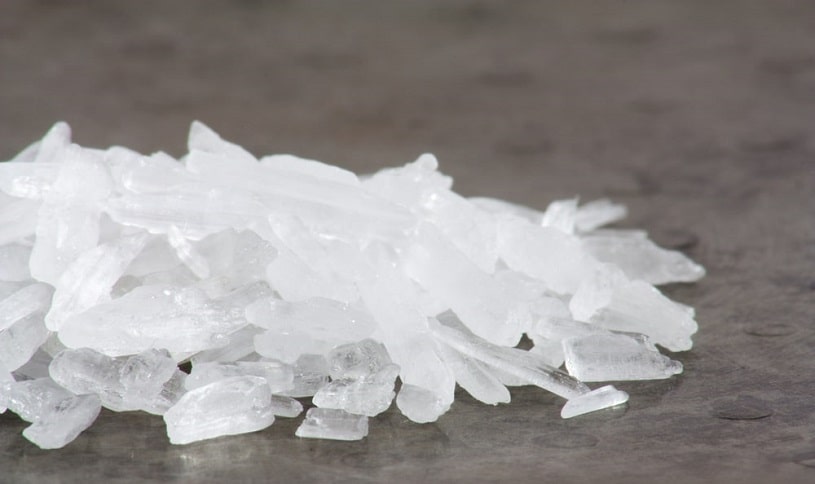Crystal meth is a man-made drug that causes many dangerous physical symptoms. It is highly addictive. The drug has several names on the street, including crank, ice, crystal, chalk, glass, and Shabu (in Philippines). Those who use crystal meth often find it hard to stop, even after very few initial uses.
Table Of Contents:
Methamphetamine abuse and addiction is a major health problem in the US. Besides, the negative effects extend further to other parts of life. In fact, it reaches into the socio-economic, legal, and mental health areas.
What Is Crystal Meth?
Crystal Meth, short for crystal methamphetamines, is a man-made stimulant drug made from pseudoephedrine, an ingredient found in many over-the-counter cold medications. While most of the US’s methamphetamine is imported from Mexico, there are smaller makeshift labs in the USA– usually in individual homes or portable living compartment trailers.
The creation of the drug is dangerous due to the explosive nature of the chemicals involved in refining ingredients into transparent white, blue, or pink methamphetamine crystals, inspiring the nickname “crystal meth.”
Crystal meth addiction causes a myriad of dangerous side effects, both mental and physical. People often use it to stay awake for unnatural amounts of time. There are no legal uses for this drug.
Although crystal meth is most commonly smoked through pipes, it can also be inhaled nasally, eaten, or injected directly into veins.
Why Is Meth So Addictive?
Crystal meth is highly addictive, and even trying it just once leads to addiction. The number of people in the USA using the drug weekly is estimated at 600 000. This is because the first use of crystal methamphetamine is carving out a sensation in the brain’s reward system. Other things that caused a pleasurable sensation in the past get clouded in the brain. That is because meth affects the brain regions dealing with rewards, pleasure, cognition, and memory. This effect can and has been measured, and the drug causes the brain to produce 1,250 times more dopamine during a meth high than during sexual intercourse.
With every subsequent use of meth, the brain is forced to adapt to dopamine assault, so no high ever compares to the brain’s first exposure to methamphetamine.
This is where the expression “chasing the dragon” comes from because addicts keep using it in an attempt to recreate that original feeling. Those attempts are unachievable and only drive the users further into the grasp of crystal meth addiction.
Crystal Meth Vs. Meth: The Difference
Meth, an acronym for Methamphetamine, is a CNS stimulant medication that treats ADHD. It is available only on a doctor’s prescription. On the contrary, crystal meth is a crystalline form of the medication that has no medical use. In fact, it is an illegal drug. Both these chemicals can be habit-forming and cause withdrawal symptoms once methamphetamine leaves the body.
They produce pleasurable effects on the users. It is for the same reason many young individuals develop an ongoing addiction. As a result, it will leave various adverse effects on many parts of the user’s life. For example, their health, relationships, academic performance, and the list goes on.
Crystal Meth Schedule
Crystal Methamphetamine is classified as a Schedule II substance under the Controlled Substances Act. It means that the drug has a high potential for abuse and can lead to severe psychological and physical dependence. Crystal Meth is illegal and has no medical use, therefore any use of this drug is considered abuse and can lead to legal consequences.
What Does Meth Do?
Methamphetamine is so effective in making people come back for more because its sole purpose is forcing the brain to pump out dopamine. Dopamine is the neurotransmitter responsible for the feeling one gets when feels accomplished or has the satisfaction of a job well done. Normal dopamine is triggered by a variety of everyday situations or activities. But when one gets involved in meth, it takes control of that function and starts pumping out way more dopamine than is healthy. With continued use over time, the dopamine receptors in the brain actually get destroyed. This means that the brain has no other way to experience pleasure other than through the drug. If crystal meth use gets to this stage, of course, treatment and therapy can bring rehabilitation, but there is a considerable risk that the damage caused is permanent.
What makes this process even more frightening is that methamphetamine releases such a burst of pleasure in the brain during its first use that addicts often will admit they were hooked the first time they tried it. That is where the now-famous saying came from “Meth, not even once” because one try may be all it takes to open the door to long-term consumption and addiction.
Crystal Methamphetamine Statistics
Today, methamphetamine is still an illegal drug with a big user base. This is causing thousands of deaths every year. Fortunately, a great number of addicts seem to opt for treatment. As a result, they decided to seek help at professional rehab clinics.
According to the 2017 National Survey on Drug Use and Health (NSDUH), about 1.6 million people in the world reported using methamphetamine in the past year, and 774,000 reported using it in the past month. Furthermore, 0.5% of high school seniors reported using methamphetamine in the past year as of the 2019 Monitoring the Future Survey.
Methamphetamine abusers are usually young adults. The average age is approximately 23 years old. According to a report, an estimated 964,000 people in the United States were diagnosed with methamphetamine use disorder in 2017. These records stress the need for more treatment facilities to tackle the debilitating situation of abuse and addiction.
Mixing Meth and Alcohol
Alcohol reduces the metabolism of methamphetamine and prolongs the effects of the drug, which results in repeated craving and abuse. This can also result in a meth overdose by its accumulation in the system. Individuals who consume more alcohol become more likely to abuse meth. When both substances are taken together, their effects are increased reinforcing drug use. Since alcohol impairs judgment, it makes a person take risks and try drugs more often, leading to addiction.
Alcohol and meth both have their side effects. The combined intake of the two substances can display a combination of side effects of both. This combination can negatively affect mood, cause dangerously fast heart rate, hospitalization, organ failure, overdose, and even death.
Abusing methamphetamine with alcohol deceives a person about the amount of alcohol their body can handle, leading to alcohol poisoning. Individual overdose of these substances can result in coma. Combined overdose of both substances can result in a worse coma or death.
Crystal Meth Addiction Signs
No matter which route of administration was chosen, a methamphetamine user will experience a swift onset of the effects. If someone is abusing meth, it can result in different symptoms, both physical and behavioral.
Physical Symptoms Of Crystal Meth Addiction
As an addiction develops, physical symptoms of meth use start to show up. Crystal methamphetamine has its effect on the body, which results in various manifestations, ranging from moderate to severe, depending on the severity of the addiction.
Physical Symptoms Of Methamphetamine Addiction Include:
- Blisters or sores on the face and mouth
- Tooth decay
- Bloodshot eyes
- Extreme weight loss or loss of appetite
- Increased breathing rate
- Dilated pupils
- Anxiety
- Paranoia
- Doing repetitive, absolutely meaningless tasks
- Tremors
- Bad breath and a dry mouth
- Chronic headaches
- Extreme fatigue
- Heavy sweating
The user’s persistently elevated heart rate places them at the risk of a heart attack. Those who use crystal meth may also feel as though bugs are crawling over them or have uncomfortable sensations under the skin.
Methamphetamine Abuse Warning Signs
There is no way to know for sure whether someone is using drugs unless a drug test is performed. However, numerous warning signs do exist that may indicate someone is using drugs and can be regarded as symptoms of meth use.
Those Who Are Using Drugs May:
- Have needle marks on arms, legs, or between toes
- Have a lack of personal hygiene
- Lose interest in activities they once enjoyed
- Become withdrawn or isolated from others
- Begin exhibiting aggressive or irritable behaviors
- Become absent from work or class
- Lose touch with friends and family members
- Act secretive or like they are hiding something
- Pick at their skin, often leading to sores and abrasions
- Remove or steal light bulbs. They can be turned into a smoking pipe
- Be unable to function normally at home or work
- Be extremely talkative
- Experience paranoia
- Stay awake all night, and for prolonged bouts
- Be unable to eat at meals
When under the influence, the user may show increased physical activity due to the hyper activeness caused by the drug. An addict’s behavior will be unpredictable. This can be very dangerous for the user, as well as those around him or her. It is entirely possible for a crystal meth addict to show signs of violent behavior.
On top of that, an unusual loss of appetite will occur. Eventually, it will lead to rapid weight loss. This is why people addicted to methamphetamine usually look thin and malnourished.
Many drugs share the symptom of unconscionable clenching of the jaw. Sometimes, it’s not just caused by stress, it could be a sign of addiction. One can also often hear a methamphetamine addict wheezing, not because they are sick or have asthma. However, it’s because methamphetamine addiction causes respiratory or airway abnormalities.
Meth Addiction Treatment: Getting A Rehabilitation For Methamphetamine
The essence of rehab for methamphetamine addiction is to provide quality health care to those suffering from symptoms of dependency on Methamphetamine.
There are many methamphetamine treatment centers located in every state in the U.S. and other countries. There are also support groups such as meth anonymous, which are helpful in many ways. These facilities are specially instituted to provide meth addiction help to individuals struggling with the effects of the drug in their lives.
The methamphetamine recovery process begins only after a person has suffered enough negative consequences that he or she is compelled to enter treatment. Once in treatment, the addict makes significant lifestyle changes necessary for maintaining sobriety.
The best way to fight this addiction is to find a credible rehab and attend crystal meth anonymous meetings nearest in proximity. It is vital to seek professional help as early as possible to expedite recovery and live a healthy, drug-free life.
Why Should One Seek Professional Treatment For Meth Addiction?
This kind of addiction is best treated in a methamphetamine rehab. Some individuals may attempt to treat an addict or themselves without a medical professional’s aid, probably due to the lack of funds for full methamphetamine detox and therapy. These individuals most often realize that self-treatment is impossible, and the only way out is a rehab for methamphetamine addicts.
People who are undergoing meth addiction treatment, even in rehabs, find it very challenging and tedious to scale through. In many cases, aftercare programs are required to maintain sobriety, as well as support groups and CMA meetings to ensure a healthy physical and mental state. One must seek treatment for methamphetamine addiction in a rehab facility.
Here Are a Few Reasons Why:
- Coping With Dependencies. A medical rehab will ensure the safest and most effective way to reduce dependency levels until complete independence from the drug is achieved. This process includes meth addiction treatment medication and other exclusive medical services that one cannot access if the individual decides on self or home treatment.
- Treatment Of Psychosis. Psychosis is one of the known symptoms of addiction to methamphetamine. A rehab for methamphetamine addiction treats various levels of psychosis with medications that will enable the patient to regulate their mental state.
- Relapse Prevention. The uncertainty of relapse after recovery from methamphetamine is quite substantial. A good number of persons still live with high relapse potential, even after rehabilitation. Relapse prevention programs are of the utmost priority in methamphetamine rehab centers.
- Emotional Transformation. Some individuals, after they are cured from addiction to methamphetamine, may find it difficult to find pleasure in things that they previously did. Treatments for meth addicts in an institution include programs that mitigate these mental states and bring back a normalcy degree.
- Reorientation And Living A Better Life. Crystal meth rehab centers provide all the reorientation and induction into a new and healthy lifestyle. Support groups help them improve their communication and social skills to fit into the system.
- Proper Medication Therapy
- Professional Monitoring And Evaluation
Lastly, meth addiction treatment centers are serene environments, well equipped with facilities, and a place where one can get the best help from medical experts who are available on a 24-hour basis to monitor and evaluate the healing process.
What Is The Treatment For Crystal Methamphetamine Addiction?
The methamphetamine treatment can be grouped into 3 main stages. Each stage has a significant set of strategies and actions that should be carried out to heal the brain of chemical reactions that it has become accustomed to. The three stages of treatment include:
| Stabilization Stage | Intensive Care Stage | Supervision Phase | |
|---|---|---|---|
| What It Aims At | Detoxification therapy and managing withdrawal symptoms | Changing lifestyle patterns, habits, and ways of thinking that characterize meth addiction | Educating and supporting the patient as well as family members or guardians to prevent relapse |
| Difficulties/Risks | Withdrawal Symptoms | Cravings | Risk of Relapse |
| Treatment Methods | Medication therapy such as antidepressants to help with the symptoms | Cognitive-behavioral therapy, teaching patients:
|
|
The length and type of treatment an addict needs depend on the severity of the addiction. The more intensive treatment experiences occur in 30-, 60-, and 90-day inpatient rehab facilities, where patients learn how to cope with their addiction first and are then expected to implement what they’ve learned once they’ve left the facility. Outpatient rehabilitation programs allow patients to live at home and require them to participate in meetings and therapy sessions multiple times each week; outpatient programs are useful in helping patients work through real-life problems as they occur.
With either treatment method, patients learn a new skill set that will help them succeed in leading satisfying, sober lives.
Can a Meth Addict Be Cured?
No matter how distant the memory of your addiction becomes, addiction is still a mental disease. Unlike an infection, which ceases to cause harm once all bad bacteria are gone, an addiction stays with a person because the chemicals that the person ingested altered parts of the brain and its functions. Does this mean a recovering meth addict will always crave the drug?
Not necessarily. While some struggle to stay sober years after their last use, others become extremely comfortable with their sobriety after only a year or two. The brain can be re-wired to think about methamphetamine differently. Once a person has been sober long enough, they will be able to see with accuracy just how much pain and suffering their addiction has caused, not only for themselves but also for others. What once caused a dopamine rush can make a person sick to their stomach if therapy sessions and other forms of treatment are taken seriously.
While there is no cure for meth addiction, things do get easier with time, and if a person is willing to put in the effort, he or she can find happiness and comfort in long-term sobriety.
The Healing Stage: Ongoing Recovery
There will be a number of ups and downs throughout the recovery process. For some people, just a few weeks of sobriety will have him or her feeling fantastic. These few weeks without the drug have allowed the body to partially replenish what it has lost in dopamine production, causing feelings of joy, positivity, and strength.
Cravings may become less severe, and anhedonia begins to subside— life starts to seem interesting again. This is called the “honeymoon” phase, or the “pink cloud.” Some experience it, while others do not. If a person withdrawing from methamphetamine experiences this “honeymoon” phase, he or she needs to be prepared for the inverse: a phase called “the wall.” Many people who describe having this uplifting, joyful period soon after acute withdrawals eventually hit a wall of depression, anxiety, and other psychological symptoms that make resisting cravings more difficult for a certain amount of time. This “wall” usually pops up between months one and two of sobriety; it does not usually last longer than three months.
By month six of sobriety, a person recovering from a meth addiction should start to feel themselves leveling out a bit; this healing stage is a period of physical, psychological, and social adjustment for the recovering methamphetamine addict. Some people notice a world of difference after a year of being sober. Some days, a person’s past meth addiction may even seem like it was so long ago that even thinking about it feels odd. For others, the psychological symptoms and effects of withdrawing from meth can remain for several years after quitting.
Some days will be better than others, but recovery is an ongoing process. Continuing to attend meetings and surrounding oneself with healthy, supportive individuals are some of the best ways to maintain sobriety during the healing stage.
Getting Help For Crystal Meth Addiction
Because crystal meth is so addictive, it is very hard to stop without professional help. Those who attempt to quit “cold turkey” or without the right guidance often relapse quickly. There are a few types of professional help one might receive when trying to stop using crystal meth. It is vital to be aware of the different symptoms of meth use to intervene in time.
The best way to quit methamphetamine is to start with an inpatient rehabilitation program at a treatment center. These facilities allow a person to detox safely while under the supervision of medical professionals. Outpatient programs and support groups are useful for maintaining sobriety. Quitting the drug may help prevent dangerous adverse reactions and meth overdose.
Page Sources
- National Drug Intelligence Center. Crystal Methamphetamine Fast Facts https://www.justice.gov/archive/ndic/pubs5/5049/5049p.pdf.
- Nora D. Volkow, Gene-Jack Wang, Lisa Smith, Joanna S. Fowler , Frank Telang, Jean Logan, Dardo Tomasi.Recovery of Dopamine Transporters with Methamphetamine Detoxification is not Linked to Changes in Dopamine Release. 2015. https://www.bnl.gov/isd/documents/92586.pdf.
- Luo YL, Bian JW, Zheng ZJ, Zhao L, Han S, Sun XH, Li JF, Ni GX. Effects of methamphetamine abuse on spatial cognitive function. 2018. https://www.ncbi.nlm.nih.gov/pmc/articles/PMC5882954/.
- Cadet JL, Brannock C, Jayanthi S, Krasnova IN. Transcriptional and epigenetic substrates of methamphetamine addiction and withdrawal: evidence from a long-access self-administration model in the rat. Mol Neurobiol. 2015. https://www.ncbi.nlm.nih.gov/pmc/articles/PMC4359351/.
- Karila L., Weinstein A., Aubin H. J., Benyamina A., Reynaud M., Batki S. L.. Ballester J., Valentine G., Sofuoglu M. Pharmacological treatments for methamphetamine addiction: current status and future directions. Expert Review of Clinical Pharmacology. 2017. https://www.ncbi.nlm.nih.gov/pubmed/27927042.
- National Institute on Drug Abuse. What treatments are effective for people who misuse methamphetamine? 2019. https://www.drugabuse.gov/publications/methamphetamine/what-treatments-are-effective-people-who-misuse-methamphetamine.
- Gantos MA, Manzotti A, Yuan JC, Afshari FS, Marinis A, Syros G, Rynn MH, Sukotjo C. Prosthodontics treatment considerations for methamphetamine-dependent patients.J Prosthodont. 2015 https://www.ncbi.nlm.nih.gov/pubmed/25627552
- Ruiz, P., & Strain, E. 2011. Substance Abuse: A Comprehensive Textbook, Fifth Edition. Philadelphia, PA: Lippincott Williams & Wilkins. National Institute on Drug Abuse. 2015. DrugFacts: Methamphetamine. https://www.drugabuse.gov/publications/drugfacts/methamphetamine
More About Illicit Drugs:

 Authored by
Authored by  Reviewed by
Reviewed by 





